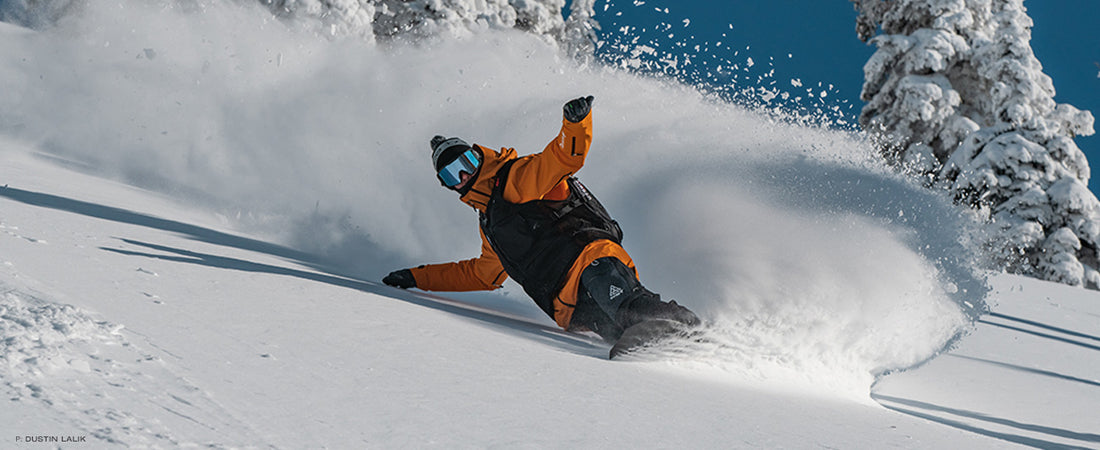
A sign of a job well done: Liam Griffin being carried off the helipad at Selkirk Tangiers, just outside Revelstoke, BC, by Travis Rice, Sage Kotsenburg, Nils Mindnich and Jared Elston. Photo: Colin Wiseman
This article was first published in Issue 22.4.Liam Griffin hasn’t been sleeping much. He’s on his 19th consecutive day as the Chief Operations Officer of Natural Selection Tour at Revelstoke Mountain Resort, BC. Earlier today, he and his crew pulled off a successful heli-based finals day, despite a dicey snowpack. All went smoothly. He’s the good kind of tired.
If you want a measure of success, many of the riders, the best backcountry riders in the world mind you, claimed they had their best runs of the year today. At the end of it all, Liam took the last flight back to the staging area and was chaired off the heli pad by Travis Rice, Jared Elston and Sage Kotsenburg. Hand the man his flowers, please.

Mark McMorris charging downhill as the heavy drone follows, broadcasting live from Montana Bowl in the backcountry of Revelstoke Mountain Resort. The live backcountry broadcast is a sometimes taken for granted but very technically impressive aspect of the Natural Selection Tour. Photo: Colin Wiseman
If you’re not familiar with Liam, I’d argue he’s one of the most important people in snowboarding today. His work ethic and attention to detail saw him rise to Global Event Director with Burton for the latter half of the aughties followed by nearly a decade of freelance event production before co-founding the Natural Selection Tour. As the COO, he’s the guy who makes things happen, overseeing the production in full. And he does it with immense care. He cares about snowboarding, its people, its culture. That shows in the direction of this event, intending to showcase backcountry freestyle snowboarding in a format that a casual viewer can understand.
Evidence of Liam’s commitment to the core is the success of Natural Selection Tour 2024. From their experimentation with international duels to the main event in March, it was a tricky snow year. It wasn’t perfect, but we can’t control the weather. And the crescendo in Revelstoke was about as good as it gets. So, I sit with Liam at a bar at the base of the mountain, both of us still buzzing off the day’s events, and try to capture the moment in conversation, to see what it really takes to make something like this go.

Some of the world’s top backcountry riders, all smiles at the end of the contest day in the Selkirk-Tangiers tenure. Left to right: Jamie Anderson, Travis Rice, Hailey Langland, Mikey Cicarelli, Marion Haerty, Torgeir Bergrem, Nils Mindnich, Jared Elston, Austen Sweetin, Sage Kotsenburg and Mary Rand. Photo: Colin Wiseman
Tell me how you feel right now.
Stoked, relieved, proud.
It was a big lift to pull this thing off.
Originally, we were looking at a goal of two days of live broadcasting across two different venues, which was kind of a psychotic thing to try. We were looking at the weather and the snowpack. There was a considerable mid-season meltdown in BC, record low snowpack, then high avy danger. We opted to shift day two to an “as live” broadcast.
It was obvious we could make it happen here at Revelstoke Mountain Resort because we knew we could get in
The day before we went live, I had one crew at the RMR venue and another crew in the backcountry getting the Mosquito venue ready. It was day 17 of production: first gondola every morning, first lift in the heli, last ones off the mountain, then spreadsheets and emails until you go to sleep.
It’s such a monumental undertaking with so many moving pieces to do productions like this in locations that aren’t really set up for it. Even with daily work in the Montana Bowl
Once ski patrol poked around the west side of the venue, it was a little less steep, a little more supported, and it was fine in there. It proved that just the west side could support the 48 runs that we put down in it, besides a few riders who still tapped into what was left of the East side.
And this was just the first phase of building the venue. Travis
It’s year one, but the work that Dustin
How much of the success can be attributed to having a strong resort partner and community backing it?
In general, as someone who’s produced resort-based events all over the world, Revelstoke has been one of the most supportive partners I’ve ever worked with. They have long-term goals for this resort, and part of those goals include things like Natural Selection. The head of mountain ops, the head of slopes and the head of grooming were all up there doing the work with us—hands on in the trenches, helping us make it happen. During the first vision quest that Travis went on,
They’re just totally down. So is the local community—opening ceremonies sold out, Yeti movie night sold out, closing night sold out. It’s a small, tight-knit community of people who are just down to support snowboarding and this vision that we have.
Are you already thinking about next year?
I’ve been thinking about it since we started building in Montana Bowl. Again, to speak to the community here, nobody poached the course. I didn’t hear any complaining about the fact that Montana Bowl had been closed for a couple of weeks for the event, because all the locals got to ride it all December, all January, most of February until it was closed. And they were stoked on it because it was way more fun to ride than what was there before. Once we closed it, everybody who was out there touring was cruising past, high-fiving, excited to see what would happen. A bunch of people went and rode it today, now that the contest is over.
Having the integration of the heli op, Selkirk Tangiers, and the resort gives us so much space to move and grow. I can see us continuing to invest with RMR in this legacy project in Montana Bowl. Eventually, they’ll hopefully have chairlifts out there—maybe a big screen, full spectators.
A backcountry stadium…
How insane would that be? At the same time, we’ll be unlocking new pieces of the Selkirk Tangiers tenure because they’re securing new staging areas that allow for shorter flights to the venues, which are required for this kind of production.
So, you’re excited.
Yeah, I love this place. I might buy a house here. I’ve been looking for an excuse to move back to Canada
What were the biggest challenges you faced?
Weather, always. Anybody who films snowboarding in the backcountry understands that weather is the wild card. Is it sunny? Is it cloudy? How much did it snow? Did it snow too much? Was it too warm? Too cold? Is
We were under a special public avalanche warning for a huge portion of the pre-production window. It was something we took seriously. But through mitigation, homework and control, we were able to work through it. I’m glad that East Bowl slid when we were doing control work. Despite the work we put in before the event, that piece of terrain still wasn’t safe. Had we not done the work, it could have been catastrophic. That’s the first time we’ve ever had an avalanche in venue
That speaks to our commitment to safety, working with patrol and allowing them to do what they need to do to be in a position where they feel comfortable with us showing the world a live broadcast.
Anything else you’d like to add?
I want to thank all the riders. This has been a really collaborative process over the last four seasons. We’ve been writing the script for this as we go along because there’s no rulebook for how to do events in the backcountry. We haven’t done everything right every time, but through the participation of some of the best riders in the world, having hard conversations and listening, I think we’re getting better every year. I don’t know where we’re going to be four years from now. I couldn’t have told you in year one where we’d be today.

An early morning arrival for Griffin and crew—long days are the norm during contest time. Photo: Colin Wiseman


